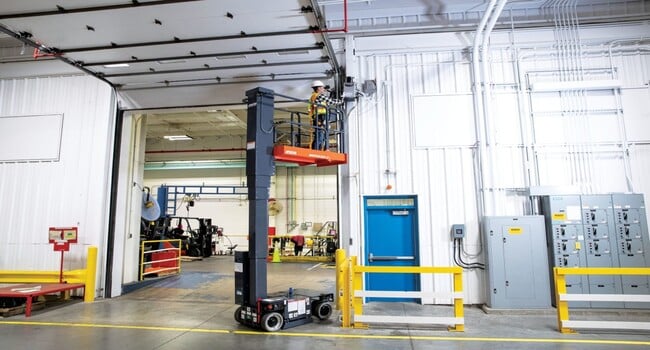Innovative equipment plays a vital role in the dynamic construction industry, where efficiency, safety, and accessibility are key. Driveable vertical masts and boom lifts, among other construction equipment, are essential tools. These versatile platforms have many advantages that enhance productivity and increase safety on construction sites. In this post, we will discuss the various benefits and importance of drivable boom vertical mast lifts.
Understanding Drivable Vertical Mast Boom Lifts
Drivable Vertical Mast Boom Lifts (or Personnel Lifts) are specialized aerial working platforms designed to elevate employees to various heights while maintaining a safe, controlled environment. Unlike scissor lifts or articulated boom lifts, which use wheels or tracks, vertical mast boom lift feature a compact, vertically extended mast to provide vertical lift capability. These lifts have a drivable mast, allowing the operator to move them easily on construction sites.
Enhanced Accessibility
They provide unmatched accessibility to elevated working areas. The compact design of these lifts allows them to easily maneuver around tight corners, narrow aisles, and other confined spaces. This accessibility, particularly useful in construction settings where space constraints are prevalent, allows workers to efficiently perform tasks without compromising productivity or safety.
Improved Productivity
Drivable mast boom lifts can increase construction site productivity. By allowing quick and easy access to elevated areas, these lifts help reduce downtime caused by traditional methods like scaffolding or ladders. This allows workers to perform their tasks faster, more precisely, and more efficiently. Project timelines are accelerated, and productivity is increased. Also, operators can transport equipment and materials to elevated areas because these lifts are drivable. This further streamlines workflows and reduces logistical problems.
Safety
Safety is paramount for the construction industry. This is why drivable boom lifts with vertical masts are equipped with numerous features designed to keep workers safe at height. These lifts offer a more stable and secure work platform than ladders or scaffolding. The vertically extending pole provides a solid structure for the lift, while safety rails are attached to the mast and provide additional security. Several advanced safety systems, such as automatic descend systems and emergency buttons, enhance safety, reducing the risks of working at a height.
Versatility
Drivable Vertical Mast lifts are so popular because of their versatility and adaptability for various construction tasks. These lifts provide flexibility for many applications. They can be used to install overhead fixtures, perform maintenance, or finish a project. These lifts are perfect for indoor renovations and ceiling installations where space is limited. In addition, their robust design and all-terrain capabilities enable them to operate effectively outside, making them a valuable asset for outdoor and indoor construction projects.
Cost-Effectiveness
Drivable vertical masts and boom lifts benefit construction firms, including superior performance. These lifts can reduce labor costs and boost project efficiency because they minimize the need for manual work and decrease the time it takes to complete a task. Durability and reliability are also important in reducing long-term costs by reducing equipment downtime, maintenance, and other expenses. A construction company can also maximize the return on their investment with these lifts by utilizing them in various projects.
Conclusion
Drivable mast boom lifts, with their many benefits, are a must-have in today’s construction industry. They improve safety, productivity, and efficiency. These lifts facilitate elevated work by improving accessibility, safety, and efficiency. Construction methods will continue to change, but drivable mast boom lifts that can be driven vertically will remain a valuable asset for construction firms looking to optimize operations and improve the success of their projects.
